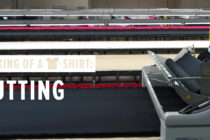The Metrics and KPIs Every Print Shop Should Track
Bruce Ackerman is the founder of Printavo, a popular print shop management platform. More than 3,000 shops across the world use Printavo to simplify and understand complex custom printing production processes. Bruce and his Chicago-based team are dedicated to helping print shops get organized and grow. You can read more from Bruce and his team on Printavo’s PrintHustlers Blog.

As we approach the holiday season and push toward the end of 2019, it’s the perfect time to take stock of your print shop’s overall health.
This doesn’t mean checking your bank balance, doing check-ins with your employees, and walking the shop (though those are important, too). It means looking at real, trackable metrics for success and determining whether you’re getting worse, getting better, or staying stagnant.
These key performance indicators can guide decision-making, point toward areas you should focus on, and (most importantly) help you understand when it’s time to celebrate your efforts.
You can start fresh by tracking these metrics on a monthly basis. Take a microscope to your business: where can you grow, improve, and strengthen your business? Make a habit of checking on these metrics on the 10th of every month – big changes can be a call to action.
These metrics can help you make decisions to shore up your gross margins and simplify your cash flow. They’ll give you a snapshot of the overall health of your printing operation.
Let’s dive in.
Cost of good sold (COGS)
Cost of goods sold (“COGS”) are the costs directly related to the materials you use in your business to produce finished garments. The way to track this is to compare your COGS to your overall revenue – you should have a simple percentage of COGS compared to revenue. Your accountant can help you set this up.
The goal is to keep the cost of goods sold as low as possible. Once you’ve captured the data, try to move the needle each month: where can you reduce waste? Some ideas include:
- Standardizing your ink colors
- Improving your wholesale ordering process
- Negotiating with vendors for lower prices
Some shops track labor as a COGS value. This is particularly useful if your labor costs aren’t fixed – you can see how your labor costs relate to your revenues over time.
Volume produced
Volume per week. This number is fun!
Print shops are highly seasonal businesses. You will see highs and lows throughout the year. The great thing about your weekly volume is that it gives you an intuitive sense of your progress.
If your volume produced last week was small, but you worked your tail off and wore your staff thin – you know something is off. Perhaps it’s time to start looking for a contract printer to help you with the volume.
If you think your volume was very low, but you find it’s actually high – maybe it’s time to start selling more jobs.
Volume produced per day.
Here’s a number that will offer some surprises, both pleasant and unpleasant.
Our industry isn’t one where Fridays are relaxed. You’ll find patterns that emerge: the work-week has real peaks and valleys for production. You can beef up your staff, introduce flexible schedules, or plan for more capacity in anticipation of your busiest days.
Even better, you can help even out the workload when you know your daily volume. You can beef up your staff in anticipation of busy days, introduce flexible schedules on slow days, or plan to contract out jobs in anticipation of very busy crunch periods.
Volume produced per hour.
Want to get detailed? Start tracking your volume per hour.
This is a wildly powerful metric for pricing, staffing, and generally understanding how capable your business is. To track it, you check your volume per day and divide it by the number of working hours in your shop.
The number that your press says – be it 300 units per hour or 1080 per hour – isn’t your real volume per hour. So be sure you’re accurately tracking your shop’s productivity.
Average job size
There are two ways to break down your average job size: by cost and by volume.
Average job size by cost.
Do you know how much your average order is for? If you segment and analyze your customers, you’ll likely find that your “bread-and-butter” – i.e. a large chunk of your revenue and profit – comes from about 20% of your customers.
I’ve talked to shops that have calculated the exact kind of customer they want to target, and their average order was about $700. However, these customers returned again and again, year after year, delivering a tremendous lifetime value. Since you’ve likely already paid to acquire
these customers, targeting them with advertising and marketing efforts offers a huge potential return on investment.
Average job size by quantity.
Basic screen printing pricing theory tells us that a 100 piece job is more profitable than 100 single-piece jobs. Why? Because of setup and breakdown time! Once you start printing the 100 piece order, you quickly become “profitable” after (typically) 12 to 24 shirts. Therefore, it’s imperative to understand your average job size so you know whether you are trending toward smaller (less profitable) or larger (more profitable) jobs.
Knowing your average job sizes helps your sales team understand where they need to focus. Should they pursue high-volume jobs, or look for more customers with smaller orders? When you know what your business is doing – and what you’re actually good at printing – you can organize sales efforts in an orderly and sensible way.
Top 10 customers by revenue
You should make a list of your top 10 customers for every month.
Put this somewhere visible in your office. Big customers need more attention – they make up more of your business, so you should “spend” more of your resources to serve them.
When their names are visible and everyone knows who they are, you’ll provide that white-glove service that big clients love.
If you keep tabs on your top 25 to 50 customers each month, you can see:
- Seasonality
- Your big customers in September probably aren’t your big customers in June. Do you know when you should target your biggest clients?
- Growth and change
- Is a new client appearing higher in your rankings? Is a formerly great client losing business? You’ll have an intuitive sense of this if you track your top clients.
- Lost customers
- Did a big customer jump ship? Did a big re-order not happen? Find out if you dropped the ball…quickly.
Tracking your top customers keeps you in-tune with the month-to-month rhythms of their business. You’ll be able to market intelligently and provide even better service for mission-critical clients.
New vs. returning customers
Remember: you want to consistently introduce new customers to your business. Customer churn is inevitable – but if you track it carefully, you can take steps to mitigate it.
Each month, run a report that shows the number of new customers you began working with compared to the number of returning customers you worked with. This should be a simple ratio: 27 new customers, 32 old customers.
The way you approach new and old customers should be different! “You never get a second chance to make a first impression.”
Year-to-date sales (compared to last year)
You should have your YTD sales numbers memorized. They are such a powerful and simple way to keep tabs on your sales, marketing, advertising, and continuous improvement efforts.
Each month, take stock of the month’s revenue and profits – and compare it to last year. As you continue to make small monthly victories, you’ll see your sales volume snowball. Each monthly increase adds to your bottom line for the year.
This process of ongoing monthly evaluation makes growth discrete – you approach each month on its own terms with an eye toward your last year – but also holistic, since you’re taking a long-term view of your business.
Setup and break-down times
The simplest way to make more money in your print shop is to stop doing things that don’t make you money.
Setting up and breaking down jobs – burning screens, registering them on press, cleaning and reclaiming them – is necessary. But it isn’t how you make your money. You do that when you’re printing.
But setup and breakdown times are often not accounted for by print shops – much less analyzed and tracked in a rigorous way.
Do you know how long it will take your shop to set up a job? Do you know, within 10 minutes, how long your shop spends on screen reclamation for any given job?
You are paying someone to do these tasks (if you’re not doing them yourself)! The leaner, faster, more dialed-in shops – that ruthlessly track their setup and breakdown times – can simply print more jobs than other shops. They can offer better pricing.
Having a streamlined, standardized setup and breakdown procedure is valuable. Tracking that time and the associated labor cost is the secret sauce for improvement. Efficiency isn’t an accident!
Shop utilization
Here’s a frightening fact from industry expert Mark Coudray. In studying hundreds of print shops and doing extensive time studies, he’s learned that most print shops are operating at less than 30% utilization.
That means that ~70% of the time they aren’t actually printing. N ow, every shop owner knows the adage, “If your press isn’t spinning, you aren’t making money.” It seems obvious. But utilization is something you can actually track.
So how do you track utilization? Time studies! You can compare the time your press is actually in operation with the time spent doing setup, breakdown, and all other tasks in your shop.
If you boost your utilization, you typically boost your revenue and profit with it. That isn’t always the case (you can absolutely grow your revenue and not take more profit), and utilization isn’t necessarily about printing faster so much as utilizing your shop’s primary resource (time) effectively.
Customer lifetime value
If you take only one KPI away from this article, let it be lifetime customer value. Fewer than 5% of online businesses bother calculating this metric (according to Smile.io), but it’s a huge one.
There are several ways to calculate this, and you may need help. But the basic and simplest formula involves following these steps:
- Calculate your average order value. Total Revenue divided by Total Number of Orders.
- Calculate purchase frequency. Total Number of Orders divided by Total Unique Customers.
- Calculate customer value. Multiply your average order value by your purchase frequency.
- Calculate (or estimate) your customer’s average lifespan. You will likely have to fudge this at first – it’s not unrealistic for a customer to stay with your shop for 3 years. If you want to be more conservative, you can estimate 1 or 2 years. You can begin tracking this as well (simply note when you acquired a customer).
- Then, calculate your customer lifetime value. Take your calculated customer value above and multiply it by your customer’s average lifespan. This gives you a dollar amount for the lifetime value of a customer.
If you have a customer that usually spends $750 a year in your shop and they’ve stayed with you for 3 years (and you assume they’ll stay with you for 3 more years) then their (simplified) customer lifetime value is $750*6=$5,500.
This is a wildly valuable metric if you can begin tracking and calculating it. You can place customers in cohorts depending on their lifetime value – low, medium, and high value – then use qualifying questions (or even lookalike audiences in Facebook) to determine how aggressively to pursue individual customers.
If you don’t track it, you don’t see it
Metrics and KPIs are crucial to getting a handle on the health of your print shop.
There are a thousand different ways to collect and analyze this data – so executing this is up to you! But the goal, ultimately, is consistency. If you are consistently monitoring your metrics and making marginal improvements, you are (over time) making very large improvements in a digestible and understandable way.
Continuous improvement is the ethos that guides the custom apparel industry – and Bella + Canvas’ products. Start tracking just one of these metrics today if you’re ready to improve.
Want to learn more about Printavo? Click here.
For more PrintHustlers Blogs, click here.
To create a wholesale account with us at Bella+Canvas, click here.
Looking for more business and marketing tips? Click here.






5 Comments
Justin Gonzalez
This is a lot of really great information! It gave me a lot of insight to think about when I work with my new customers! Thank you!!
BELLA+CANVAS
So glad to hear that our blog was helpful to you! Thanks for your positive feedback, Justin!
Stephanie
Important helpful information.
Frank Good
Really good info.
BELLA+CANVAS
Thanks for your positive feedback, Frank!